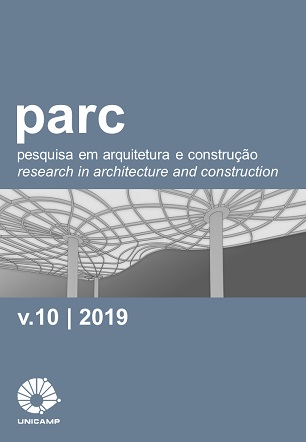Abstract
This paper aims to contribute to the understanding of strategies to introduce the parametric design in architectural design teaching. Contemporary discussions on the application of the most recent digital tools in the design are considered. Based on a theoretical and practical review, the hypothesis cogitates that only tutorial teaching of tools is not enough to parametric design learning to its full potential, and it is necessary to preview a didactic approach that includes both a change of perspective on the designed object, as well as the design activity itself. A pedagogical experiment is presented and discussed - a 40-hour extension course, applied in Federal University of Rio Grande do Norte, during the research validation stage, including the registration of the whole process and data collection with the participants. The course contained an introductory basis on the subject, design exercises with parametric tools and studio activities. The studio activities involved the design of a bicycle rack, with the participants divided into teams, brainstorming for the initial concept, the design of solutions and discussion of the final proposals. The results demonstrate that, although most participants had no previous experience with the subject, the processes and products were satisfactory, including the creation and investigation of complex algorithms, besides the recognition of the potential of parametric modeling, associated to reflexive practices in the studio. The main challenges include the changes in the usual design logic, extrapolating the use of the tool. It was observed the importance of introducing the parametric approach in teaching besides isolated didactic experiments, distributed coherently with the curricular structure of the courses, demanding the identification of the areas of knowledge in which the subject can be inserted.
References
ANDRADE, M.L.V.X.; RUSCHEL, R.C. BIM: Conceitos, cenário das pesquisas publicadas no Brasil e tendências. In: SIMPÓSIO BRASILEIRO DE QUALIDADE DO PROJETO NO AMBIENTE CONSTRUÍDO, 2009, São Carlos. Anais [...]. São Carlos: Rima Editora, 2009. p. 602-613. DOI: https://doi.org/10.4237/sbqp.09.166
BEIRÃO, J. N. Sobre o ensino da Arquitectura e o futuro profissional do Arquitecto – O Papel da Arquitectura nas sociedades criativas. J-A Jornal Arquitectos. Fórum. Crônicas. 2014. Disponível em: http://www.jornalarquitectos.pt/pt/forum/cronicas/sobre-o-ensino-da-arquitetura-e-o-futuro-profissional-do-arquiteto. Acesso em: jun. 2017.
FLORIO, W. Notas sobre pensamento e cognição em projetos paramétricos. In: ENCONTRO DA ASSOCIAÇÃO NACIONAL DE PESQUISA E PÓS-GRADUAÇÃO EM ARQUITETURA E URBANISMO, 2, 2012, Natal. Anais [...]. Natal: ENANPARQ, 2012.
GIL, A. C. Como elaborar projetos de pesquisa. 4ª edição. Editora Atlas. 2002.
KOLAREVIC, B. Designing and manufacturing architecture in the digital age. Architectural information management, 2001.
KOLAREVIC, B. Architecture in the Digital Age: design and manufacturing. New York; London: Taylor & Francis, 2003.
LAWSON, B. Como arquitetos e designers pensam. São Paulo: Oficina de Textos, 2011.
NOJIMOTO, C.; TRAMONTANO, M; ANELLI, R.L.S. Design Paramétrico: Experiência Didática. In: XV CONGRESO DE LA SOCIEDAD IBEROAMERICANA DE GRAFICA DIGITAL, 15., 2011, Santa Fé. Proceedings […]. Santa Fé: SIGraDI, 2011. p. 456-460.
OXMAN, R. Theory and design in the first digital age. Design Studies, v. 27, n. 3, 2005. p. 229–265. DOI: https://doi.org/10.1016/j.destud.2005.11.002
OXMAN, R. The new structuralism Design, Engineering and Architectural Technologies. New Jersey: John Wiley & Sons, 2010.
PRODANOV, C. C., FREITAS, E. C. Metodologia do trabalho científico: métodos e técnicas da pesquisa e do trabalho acadêmico. 2. ed. Novo Hamburgo: Feevale, 2013.
ROCHA, I. A. M. Programa e projeto na era digital: o ensino de projeto de arquitetura em ambientes virtuais interativos. Tese (Doutorado) - Programa de Pós-graduação em Arquitetura da UFRGS, Porto Alegre, 2009.
ROMCY, N. M. S. Introdução da Abordagem Paramétrica no Ensino de Projeto: resultados de uma experiência. In: SIMPÓSIO DE PESQUISA DO PPGAU-UFRN – DOUTORADO, MESTRADO ACADÊMICO E MESTRADO PROFISSIONAL, 4., 2016, Natal. Anais [...]. Natal: UFRN, 2016.
SCHÖN, D. Educando o Profissional Reflexivo: um novo design para o ensino e a aprendizagem. Porto Alegre: Editora Artmed, 2000.
SEDREZ, M.; CELANI, G. Ensino de projeto arquitetônico com a inclusão de novas tecnologias: uma abordagem pedagógica contemporânea. Pós - Revista do Programa de Pós-Graduação em Arquitetura e Urbanismo da FAUUSP, v.21, 2014. p. 78-97. DOI: https://doi.org/10.11606/issn.2317-2762.v21i35p78-97
SOARES, J.P, TRAMONTANO, M. Arquitetura emergente, design paramétricos e o representar através de modelos de informação. V!RUS, São Carlos, n. 8, dezembro 2012.
WOODBURY, R. Elements of parametric design. Routledge, 2010.
I accept that PARC Research in Architecture and Building Construction journal perform, on the original file approved for publication, revisions and modifications in orthoghaphic, grammar and standard issues.
I give to PARC Research in Architecture and Building Construction journal the rights of first publication of the revised version of my paper, licensed under the 'Creative Commons Attribution' license (which allows sharing the work with the recognition of first authorship and publication in this journal).


